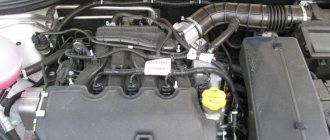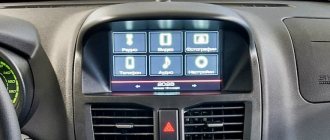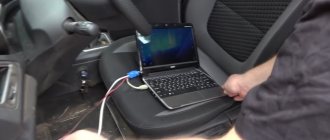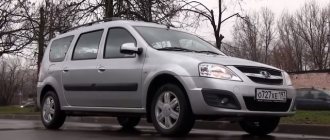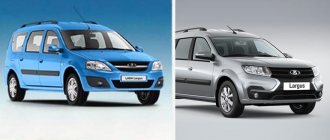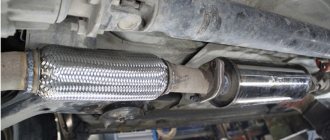Chip tuning of Lada Largus in St. Petersburg I am posting a review about chip tuning of the Largus so as not to provoke the dealer. (This is the desire of the owner of the car)
Yesterday I decided to chip my car from an SVV representative. I read a lot of forums regarding the firmware, and after consulting with the chip tuner I was convinced that the firmware would never do any harm. Largus is the same Logan, and Logans are constantly chipped. Even some Logan dealers are guilty of chipping test drive cars to make them a little more alert.
Now what happened: During the firmware process, a check was made of the standard engine control system. And check your computer for errors. Two errors were discovered caused by the installation of the alarm, unfortunately the dealer did not reset them when the integration work was completed. The mistakes were erased and there were no more comments. We started chipping. Everything was done quickly using a computer. We uploaded firmware from the author of SVV, known to many Renault and Sandero owners. For your information, the author of the firmware is a specialist in racing technology. And the SVV firmware is very close to the Paulus firmware. Differences in nuances. It was flashed for 95 gasoline and Euro-4, preserving absolutely all sensor parameters, without excluding them. As a result, the machine came to life and became faster. I was pleased with the acceleration mode, fast and confident. It feels like you have an engine with a volume of at least 1.8 liters. Moreover, you can accelerate without cranking the engine too much, just in the usual quiet mode you don’t need to switch the gearbox often - a consequence of the appearance of confident traction at the bottom. You can even pass a speed bump without switching to the first stage of the gearbox, but you should not immediately accelerate sharply into the second. I was pleased with the car's behavior on the roundabout. In fourth and fifth gears you can accelerate and overtake without resorting to the third gear. Moreover, where there are ascents and descents, the speed of movement almost did not change, as you walk 115, you continue. Only sometimes it decreased or increased by 5 km/h on an ascent or descent. The accelerator pedal did not change position. When changing the position of the accelerator pedal, the response is instantaneous! Pleased. I can imagine how much easier it would be to overtake on the highway on a long trip! And this means safety and confidence in the timely completion of the maneuver! Summary: during intense acceleration, overtaking and a calm driving style, the SVV firmware is more consistent with the characteristics of the gearbox ratios and the power indicators of the engine in combination with the vehicle’s weight. The gears have become longer and with a loaded car it is easier to blend in with the general traffic pattern. And if you are alone and in the mood, you can even joke around! You won't be disappointed! I’ll say this about fuel consumption: if you drive fast, it increases adequately to the engine speed and the ragged acceleration-deceleration driving style. I can’t say how much, because... I don’t intend to drive this way, although the new firmware provokes it. And according to the on-board computer, for mixed driving mode, consumption increased by a glass of gasoline per 100 km. I'm ready to pay for this driving pleasure. I don't want to go back to the previous firmware.
Second report on the new firmware for Lada-Largus.
While using the new firmware from SVV for Largus, new sensations and observations appeared. We were able to test the car in combat mode with the interior fully loaded. Fuel consumption indicators have become more or less available for systematization. What is the result: I was pleased with the fuel consumption, less than with the standard factory firmware, oddly enough. No matter how I tried to turn the engine, without thinking at all about saving fuel (I’m not talking about traffic light races with jerks and sharp braking, I didn’t try), consumption in city mode without loading and with loading was no more than 8.5 - 8.8 l/ 100 km. Up to 9 l/100 km. never got there. During the time with the new firmware, the total mileage was over 800 km. Like last time, in the city crowd I note excellent traction at the bottom, without a load it is quite enough, under load I have to turn the engine slightly, moving away is a pleasure, the traction weakens slightly when the air conditioning is on. On the highway I was pleased with the decent active acceleration, and the engine picks up speed quickly, which stimulates quick gear changes. It doesn't matter whether you're driving empty or loaded. What I want to note in this regard and what I talked about with the firmware installer is that when cruising on the highway, when you are driving at a decent speed, for example, 90-100 km/h, when you try to pick up speed when overtaking, you need to monitor the engine speed, t .To. There may not be enough torque for a jerk. Conclusion, before overtaking for a jerk, the engine speed should be no lower than 3.5 thousand for an empty car and no lower than 4.0 thousand for a loaded car. The improved low-end torque of the engine is good when starting off and during crowding in the city, when speeds are not so high, but on the highway it is almost unnoticeable, because The operating range of the motor lies within 3000 rpm. For efficiency, so that fuel consumption falls within the range of 7 to 7.5 l/100 km, as I noted before, it is necessary to use higher gears more often. When accelerating, try not to press the gas pedal too hard, but only lightly stroke it, and do not lower the engine speed below 1900. I noticed that at revolutions from 1900 to 3000, the most economical mode is obtained and the new firmware with improved low-end traction only helps with this . Personally, on the highway I achieved a minimum fuel consumption of 6.8 l/1oo km, while I hardly braked or changed the gearbox, and kept the speed in 5th gear no higher than 70-75 km. and did not use the classic roll-up, because... It is known that at XX the engine consumes more fuel than when coasting with the gear engaged.
What is chip tuning
The phrase “chip tuning” is formed from two words: “chip” - microcircuit, and “tuning” - improvement. The essence of the process is to change the engine control algorithms of the electronic unit to achieve better results - finalizing the factory characteristics. The ECU operates according to a specific program, which is stored in a ROM type memory (read-only memory), in accordance with various calibration tables (two- or three-dimensional). There are calibrations for different engine operating modes - starting, idling, power - and are used depending on how exactly the engine operates at a particular moment. Sensors transmit data to the controller, and it issues commands to the executive units, ensuring and maintaining stable engine operation. When adjustments are made to the calibration tables, the operating algorithm of any unit controlled by the ECU changes.
To increase power, you can change the ignition timing, fuel injection time, and the operating mode of the catalyst responsible for the toxicity of exhaust gases. You can also increase the maximum speed and many other parameters.
Chip tuning is firmware that improves the functionality of a car. It allows you to install additional electronic modules, including replacing the standard ECU with a modernized one, followed by adjusting the operating parameters of the power plant. In most cases, chip tuning involves manipulation of the factory controller.
Advantages
The Largus engine has a reserve of power and does not work at full capacity. Controller firmware will help:
- make driving easier by improving speed and traction characteristics;
- reduce acceleration time - the car will accelerate faster;
- increase engine power, which will allow you to feel almost no failures when the air conditioner is operating or at maximum load: lack of power from the factory is the main factor in the use of chip tuning.
Such tuning is simpler than a deep modernization of the engine - installing a turbine or boosting it. Installing the firmware takes no more than an hour, while the work listed above can take a week or more. Among the advantages of such modernization:
- chip tuning is an inexpensive procedure and at the same time effective;
- if the firmware is unsuccessful, you can return the engine operating mode to factory settings;
- high availability of such adjustments;
- chip tuning helps adapt the operation of the power unit to a different type of fuel - important when installing gas equipment;
- the ability to configure the internal combustion engine for changes made to the design - turning off the catalyst, cutting off maximum speed and engine speed values, removing filters.
The settings are selected according to your driving style - from economical to aggressive. Combined software has become in demand, with the help of which maximum results can be achieved from the engine.
After the firmware, there is a general improvement in performance and an increase in performance relative to the standard version by about 20%.
Flaws
Chip tuning has fewer disadvantages than advantages, but each of them can “discourage” the desire of car enthusiasts to flash the ECU. Negative aspects of the procedure:
- complete or partial failure of the engine when using incorrect firmware, during self-installation or when contacting incompetent specialists;
- reduction in engine life - indicators are insignificant, about 4%;
- incorrect setting can lead to increased fuel consumption;
- radical chip tuning with serious changes in the operation of the internal combustion engine is an expensive undertaking.
2 Chip tuning Largus Cross - small adjustments for grandiose changes
Despite its complex design and a huge number of new products in the field of automotive electronics, everyone can perform chip tuning of the Largus engine with their own hands. All you need is a little patience, computer hardware and licensed software. The latter includes:
- Combiloader loader, updated to the latest version;
- Firmware purchased strictly from the official website. For chip tuning the Lada Largus Cross, the Bosch 7.9.7 utility or the latest version January 7.2 is perfect;
- editor for configuring and calibrating firmware;
As for the equipment, for effective work on flashing the engine ECU, you need a K-Line adapter and a laptop exclusively with Windows XP. Other software will not find the firmware, which is why you will not be able to even start chip tuning.
Having all the equipment available, you can get to work. First you need to find the Lada Largus ECU. It is located behind the rear lid of the glove compartment in the station wagon. We disconnect the shield, connect the adapter and turn on the car ignition. Next, we proceed to install the programs.
First in line are the loader and editor. After their successful installation, we begin to work with the firmware. To do this, install it on your computer, indicating the final location address in the previously installed bootloader. When the latter finds the firmware, you need to configure it. In the “Settings” window you will find a lot of graphs that will help you choose the optimal characteristics for your station wagon.
Having calibrated the firmware to your liking, turn on the ignition and proceed to the most important stage of chip tuning - installing the firmware on the engine ECU. To do this, click on the “Run” window and wait for the utility installation to complete. Once the download line reaches the end and you see the “Download Complete” window, turn the ignition back on and close the installer. Next, close the bootloader and editor and turn off the ignition. After this, disconnect the adapter from the laptop and ECU.
At the last stage, you can check the operation of your car. Provided that the characteristics are properly calibrated and chip tuning is performed correctly, you will immediately notice an improvement in car dynamics, a reduction in fuel consumption by about 20% and more stable operation of the engine and transmission.
Technical characteristics of Lada Largus engines
| RENAULT, K4M | RENAULT, K7M | |
| Injection type | Electronically controlled multipoint fuel injection | |
| Fuel type | Gasoline Premium-95 GOST 51105-97 | |
| Number and arrangement of cylinders | 4, in-line | |
| Number of valves | 16 | 8 |
| Cylinder operating order | 1-3-4-2 | |
| Direction of rotation of the crankshaft (camshaft drive side) | ||
| right | ||
| Cylinder diameter/piston stroke, mm | 79,5×80,5 | |
| Working volume, cm 3 | 1598 | |
| Compression ratio | 9,8 | 9,5 |
| Toxicity standards | Euro 4 | |
| Power at 5500 rpm, kW (hp) | – | 62 (84) |
| Power at 5750 rpm, kW (hp) | 77 (105) | – |
| Maximum torque, N.m (at rpm) | 148 (3750) | 124 (3000) |
| Volume of oil poured into the engine lubrication system, including oil filter, l | 4,8 | 3,3 |
DIY chip tuning
The cost of updating the Lada Largus ECU software when contacting a specialized organization will be several thousand rubles. But car enthusiasts want to save money, so they are thinking about carrying out this procedure themselves. You can study the entire tuning process in detail, contact the experts, trust the chip box, or purchase all the necessary equipment and ready-made software from a specialized store.
Chip box
Installing a chip box is the simplest option that does not require time or large financial investments. The method is also suitable for beginners. It will be enough to figure out what type of engine is under the hood and buy the appropriate box. The device is inserted into the diagnostic connector, then all adjustments are made automatically. The procedure is fast, simple and straightforward. When the device is disconnected, the ECU returns to standard settings without any consequences.
Manual firmware
Compared to a chip box, which negatively affects the life of the internal combustion engine and other systems, flashing the chip is more effective. This is due to the fact that the process involves calibrating the operation of the controller, and does not replace signals to actuators. The controller firmware helps increase the power of the power unit and stabilizes idle speed when the air conditioner is running.
Where and how can you perform chip tuning?
Theoretically, chip tuning of Largus can be done in any place convenient for the customer. First you need to connect the programmer to the diagnostic connector. If the equipment is licensed, then it is capable of flashing a large number of different cars through the diagnostic block.
Chip tuning is a popular type of car engine modification
After connection, the control unit is backed up, the data is saved, and chip tuning is performed (replacing the ECU software). After these actions, the owner receives a completely different car, which is capable of accelerating more quickly and has different power.
Chip tuning in a car service
The chip tuning process in specialized organizations looks approximately the same. The car owner comes to the service center, where, using special equipment, the factory firmware is read from the control unit. It is then modified depending on the client’s wishes - to reduce fuel consumption, increase power, remove the speed limit. After this, the ECU is flashed with a modified program.
Often, such services already have a set of programs for different cars - in this case, the duration of the procedure is reduced. After installing the new software, the warranty period begins, during which you need to run the car in. During this time, the client may demand to correct one or another parameter that made the operation worse, or to return the money for “chipping” if the result is not satisfactory. In this case, the service is obliged to “roll back” the firmware to its factory state.
Program tuning is one of the most difficult chip tuning procedures. The complexity depends on the wishes of the driver and the system that controls the engine. Tuning consists of making changes to the existing calibrations, after which checksums are calculated. If there are already similar calibrations in the database, they will be exported to the program. These procedures are carried out without the participation of the car owner. On average, chip tuning of a Lada Largus will cost about 4-5 thousand rubles.
About the domestic VAZ 11189 engine
In April 2022, AvtoVAZ began installing domestic VAZ 11189 engines on Largus. The advantages of this engine are described in one of the issues of “Okay Mechanics”.
| Some measurement results Autoreview | |||
| Options | Cars | ||
| Lada Largus (VAZ engine) | Lada Largus (Renault engine) | ||
| Maximum speed, km/h | 157,1/156,7* | 168,0/167,6 | |
| Acceleration time, s | 0—50 km/h | 4,3/4,8 | 3,9/4,4 |
| 0—100 km/h | 13,9/16,8 | 12,5/14,5 | |
| 0—150 km/h | 61,1/71,6 | 38,9/43,7 | |
| on the way 400 m | 19,3/20,2 | 18,4/19,4 | |
| on the way 1000 m | 36,1/37,8 | 34,1/36,0 | |
| 60-100 km/h (III) | 8,7/10,6 | 9,3/10,6 | |
| 60-100 km/h (IV) | 12,1/15,1 | 12,8/14,1 | |
| 80-120 km/h (V) | 19,3/24,0 | 22,1/23,4 | |
| * Partial load/full load | |||
| Engine characteristics | ||
| Options | VAZ-11189 | Renault K4M |
| Volume, cm 3 | 1596 | 1598 |
| Number of valves | 8 | 16 |
| Maximum power, hp/kW/rpm | 87/64/5100 | 102/75/5750 |
| Maximum torque, Nm/rpm | 140/3800 | 145/3750 |
| Cylinder diameter/piston stroke, mm | 82,0/ 75,6 | 79,5/80,5 |
| Compression ratio | 10,3:1 | 9,8:1 |
| Injection type | distributed, electronically controlled | |
| Octane number of gasoline | at least 92 | not less than 95 |
Let us remind you that you can read about the VAZ 21129 engine here.
Key words: Lada Largus engine
Dimensions
Chassis
Fuel
Briefly about the design of the Lada 21129 16 valve engine
The need to use a EURO 5 internal combustion engine on new Lada models forced the management of AvtoVAZ to once again modernize its 1.6-liter 16-valve unit. Taking 21127 as a basis, the engineers changed the inlet, blocked the outlet, and filled it with new firmware.
Since the unit is now placed on a subframe, the mountings and oil pan have been slightly modified. Also, modifications were made for the installation of an alternative French JR5 gearbox.
Otherwise it's a good old cast iron block with a lightweight SPG from Federal Mogul. The supply type here is a regular injector, a toothed belt drive with an automatic tensioner, there are hydraulic lifters in the cylinder head, and the intake system is regulated by flaps.
Okay Mechanica spoke about new technologies in the domestic automobile industry.
- One way to squeeze a little more driving fun out of your car is to seek chip tuning services. They say that flashing the electronic engine control unit (ECU) makes the car more dynamic, reduces acceleration time to 100 km/h, makes the accelerator pedal more responsive, and so on.
We tried to collect reviews about chip tuning of Vesta and XRAY with a 1.6-liter VAZ-21129 engine.
We advise you to read our articles
The ECU firmware process takes 20 minutes:
The master is connected to the ECU connector in the engine compartment (in the passenger compartment, the OBD-II connector is not suitable for this; there is no registration protocol).
- Reads the standard program (so that everything can be returned if necessary).
- Compile the modified firmware.
The approximate price of chip tuning is 2500 rubles. Let's see if this engine tuning is worth the money?
RSW firmware. One of the first reviews about Vesta chip tuning appeared in the summer. In it, the author claims that after reflashing the “brain,” Vesta began to accelerate to hundreds almost 2 seconds faster (the time decreased from 16.2 seconds to 14.4). According to him, the firmware changed the response of the accelerator pedal and slightly loosened the clamp of the stabilization system (it became possible to start with a slight slip). At the end of the video review, he shares his impressions of the new firmware:
- the accelerator pedal reacts more sharply to movement, there is no delay when you need to accelerate;
- when driving, the stabilization system works much later.
Conclusion: the firmware is worth the money. You shouldn't expect a miracle, but you will definitely get a little pleasure.
Soon another review of the same firmware appeared. The Vesta owner first took readings using Racelogic in the standard configuration, and then loaded the RSW firmware. I took the values using the same software and compared the two graphs.
The only change that was noticed is that the throttle valve opens completely, somewhere in the middle of the stroke, there is no point in pressing further, nothing changes. In other words, only the accelerator pedal was stitched.
Icebreaker firmware. In a similar way (using Racelogic), a comparison was made between standard and modified firmware. According to estimates, Vesta first accelerated to 100 km/h in 219.45 meters, and after tuning the chip, the car traveled 229.47 meters in the same time. If you visualize it, the chip machine was two bodies ahead. It was also noted that in first gear the engine can be “scranked” to 7000 rpm and above.
Changes in engine operation after chip tuning
The increase in power on all types of engines installed on the Lada Largus does not exceed 7% on average, while fuel consumption decreases or remains the same. In fact, the firmware does not affect the operation of the engine in any way. Then why does the manufacturer initially underestimate the characteristics of the power plant? It's all about European regulations, according to which power is relegated to the background. Environmental standards are not the only reason for this, but one of the main ones. In order to comply with these standards, AvtoVAZ underestimates engine power and efficiency. But often low engine efficiency is associated with errors that chip tuning can easily eliminate by using reserve engine resources unused by the manufacturer.
Many car owners are interested in the question of the warranty status after updating. The answer is clear: after chip tuning, the car is removed from warranty. No official dealer will want to take responsibility and repair a car ruined by incorrect firmware.
Chip tuners claim that firmware programs are created based on factory ones, and the results of manipulations with the software are invisible. But the dealer will definitely see that the car’s characteristics differ from the factory standard, and warranty service will be denied.
CO level
With all the seemingly positive aspects of software tuning, there are still some controversial issues. Some Largus owners who have undergone the firmware procedure argue that the car should not be transferred to the Euro2 standard. Otherwise, it is unlikely that you will be able to pass the MOT safely.
And some advise removing the catalyst for this.
That's all about chip tuning of the Lada Largus car. If you have something to say or you have already done this on your car and want to share your impressions, then please write comments on the article. This is very important for all Largus lovers.
Similar articles:
- Features of installation and tuning of mudguards in Largus
- Lada Largus – interior tuning
- How to improve Largus yourself
- First tuning for Largus
- Features of radiator grilles on the Lada Largus and its independent installation without removing the bumper
Firmware for audio device on Lada Largus
The standard head unit on cars of this model does not look very presentable, but at the same time the functionality is complemented by a large number of possibilities. Unfortunately, despite the decent quality of the technical part, the manufacturers did not pay enough attention to the software. It's no secret that modern audio systems have a full-fledged electronic control unit, which is a kind of computer. There is a processor, devices for reading removable media, various connectors and other functionality. In addition, the standard radio is combined with the on-board computer.
On the other hand, the more complex the audio system, the greater the likelihood of failures and malfunctions. The radio installed on the Lada Largus is no exception to the rule. The software has not been properly tested, so malfunctions are not uncommon. The most common problems are the inability to recognize the file format, reproduce high-quality sound, or identify the removable storage device. Also on Largus, incorrect display of Russian fonts on the display is often encountered. As a result, instead of the usual Cyrillic alphabet, the driver sees incomprehensible symbols. It is in these cases that updating the device firmware will help solve the problem.
Reviews from car owners about the car's performance after the firmware
Alexander, Barnaul: “Those who are going to “sew” for a big increase in power don’t even have to start, since this won’t happen. Among the changes, it was noted that the engine began to gain speed faster, the “dullness” of the gas pedal disappeared, I was pleased with the update. Consumption decreased slightly - by about one liter per 100 km. It’s especially noticeable on the highway - you don’t need to put too much pressure on the gas pedal. According to the master, the increase in power was about 10%. Considering the presence of a trailer, it couldn’t come at a better time.”


